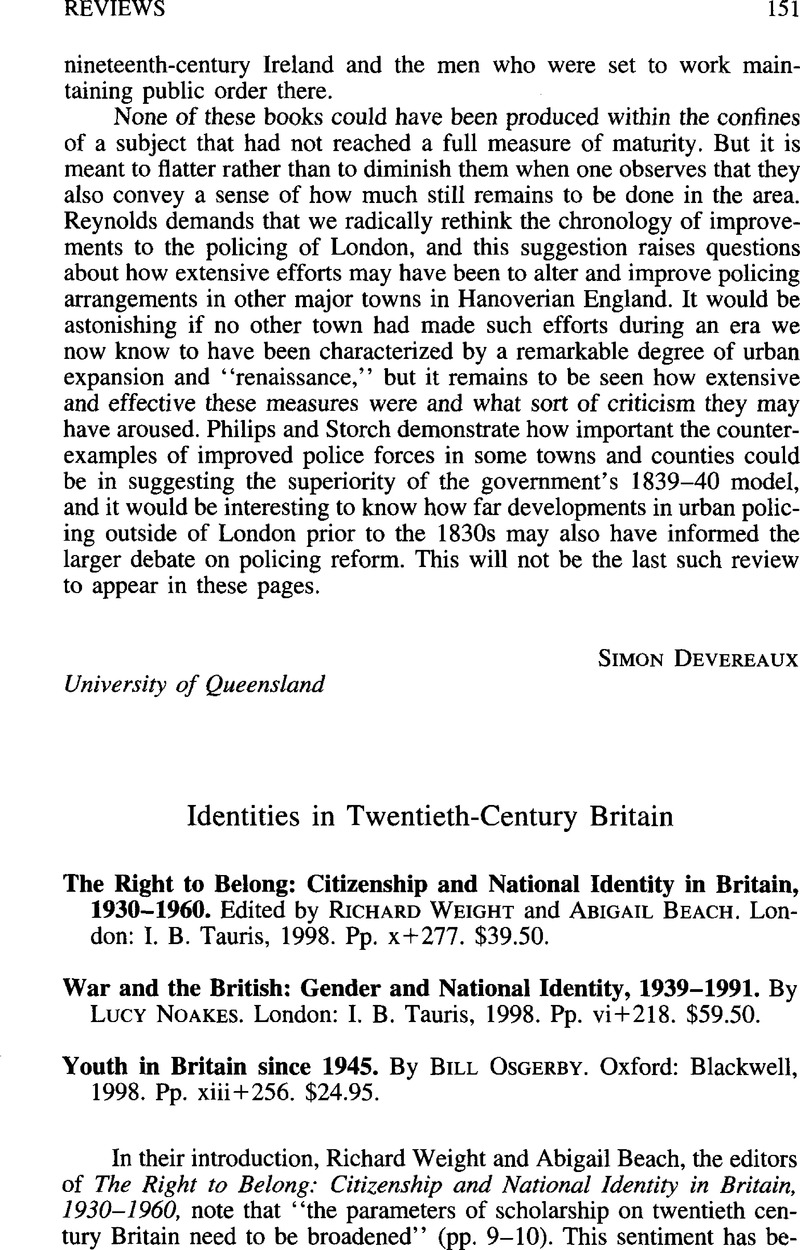No CrossRef data available.
Article contents
Identities in Twentieth-Century Britain - The Right to Belong: Citizenship and National Identity in Britain, 1930–1960. Edited by Richard Weight and Abigail Beach. London: I. B. Tauris, 1998. Pp. x+277. $39.50. - War and the British: Gender and National Identity, 1939–1991. By Lucy Noakes. London: I. B. Tauris, 1998. Pp. vi+218. $59.50. - Youth in Britain since 1945. By Bill Osgerby. Oxford: Blackwell, 1998. Pp. xiii+256. $24.95.
Review products
Published online by Cambridge University Press: 10 January 2014
Abstract

- Type
- Reviews
- Information
- Copyright
- Copyright © North American Conference of British Studies 2001
References
1 See, e.g, Vernon, James, “The Mirage of Modernity,” Social History 22 (1997): 208–15Google Scholar. The spirited riposte to this piece by Peter Catterall, Tony Mason, Jim Obelkevich, and Nick Tiratsoo might chastise Vernon on particular points, but nonetheless accepts the broad critique of twentieth-century historiography. See Social History 23 (1998): 325–30Google Scholar.
2 See Waters, Chris, “‘Dark Strangers’ in Our Midst: Discourses of Race and Nation in Britain, 1947–63,” Journal of British Studies 36 (1997): 207–38Google Scholar; Rose, Sonya, “Sex, Citizenship and the Nation in World War II Britain,” American Historical Review 103 (1998): 1147–76Google Scholar. See also Conekin, Becky, Mort, Frank, and Waters, Chris, eds., Moments of Modernity: Reconstructing Britain, 1945–64 (London, 1999)Google Scholar.
3 See, e.g., Schwarz, Bill, ed., The Expansion of England (New York, 1996)Google Scholar; O'Shea, Alan and Nava, Mica, eds., Modern Times (New York, 1996)Google Scholar; Samuel, Raphael, ed., Patriotisms (London, 1989)Google Scholar; Samuel, Raphael, Theatres of Memory (London, 1994)Google Scholar; Grant, Alexander, ed., Uniting the Kingdom? (New York, 1996)Google Scholar. See also the comments in Thane, Pat, “Twentieth-Century British Studies: Introduction,” Journal of British Studies 36 (1997): 141–46Google Scholar; and the special issue, “Britishness and Europeanness: Who Are the British Anyway?” Journal of British Studies 31 (1992): 307–414Google Scholar.
4 See, e.g., Poovey, Mary, Uneven Developments (Chicago, 1988)Google Scholar; Rose, Sonya, Limited Livelihoods (Berkeley, 1992)Google Scholar; Walkowitz, Judith, City of Dreadful Delight (Chicago, 1992)Google Scholar; Clark, Anna, The Struggle for the Breeches (London, 1995)Google Scholar.
5 See Pedersen, Susan, Family, Dependence and the Origins of the Welfare State (Cambridge, 1993)Google Scholar; Rose, “Sex, Citizenship and the Nation in World War II Britain”; Lant, Antonia, Blackout (Princeton, N.J., 1991)Google Scholar; Gledhill, Susan and Swanson, Gillian, eds., Nationalising Femininity (Manchester, 1996)Google Scholar.
6 See, e.g., LeMahieu, D. H., A Culture for Democracy (Oxford, 1988)Google Scholar; Light, Alison, Forever England (London, 1991)Google Scholar; Kent, Susan Kingsley, Making Peace: The Reconstruction of Gender in Interwar Britain (Princeton, N.J., 1993)Google Scholar.
7 Calder, Angus, The People's War (New York, 1969), pp. 20–21Google Scholar.
8 See, e.g., Harris, José, “Political Thought and the Welfare State, 1870–1949: An Intellectual Framework for British Social Policy,” Past and Present, no. 135 (1992): 116–41Google ScholarPubMed; Pedersen, Family, Dependence and the Origins of the Welfare State.
9 In addition to the already noted works by Lant (Blackout) and Gledhill and Swanson (Nationalising Femininity), see Dawson, Graham, Soldier Heroes (New York, 1996)Google Scholar.
10 See Dawson, Soldier Heroes; Segal, Lynne, “Look Back in Anger: Men in the 50s,” in Male Order: Unwrapping Masculinity, ed. Chapman, Rowena and Rutherford, Jonathan (London, 1988), pp. 68–96Google Scholar.
11 For the first, see Pearson, Geoffrey, Hooligan: A History of Respectable Fears (London, 1983)Google Scholar; Hendrick, Harry, Images of Youth: Age, Class and the Male Youth Problem, 1880–1920 (Oxford, 1990)Google Scholar; Fowler, David, The First Teenagers: The Lifestyle of Young Wage-Earners in Interwar Britain (London, 1995)Google Scholar; Gomersall, Meg, Working-Class Girls in Nineteenth Century England (London, 1997)Google Scholar. For the postwar period, see Hall, Stuart and Jefferson, Tony, eds., Resistance through Rituals: Youth Subcultures in Postwar Britain (London, 1976)Google Scholar; Frith, Simon, Sound Effects: Youth, Leisure and the Politics of Rock'n'Roll (London, 1983)Google Scholar; Willis, Paul, Learning to Labour: How Working Class Kids Get Working Class Jobs (London, 1977)Google Scholar; McRobbie, Angela, Feminism and Youth Culture: From “Jackie” to “Just Seventeen” (London, 1991)Google Scholar; Mort, Frank, Cultures of Consumption (New York, 1996)Google Scholar.
12 See Steedman, Carolyn, Landscape for a Good Woman (London, 1988)Google Scholar; Alexander, Sally, “Becoming a Woman in the 1920s and 1930s,” in her Becoming a Woman and Other Essays (London, 1995), pp. 202–24Google Scholar; Heron, Liz, ed., Truth, Dare or Promise; Girls Growing Up in the Fifties (London, 1985)Google Scholar.


